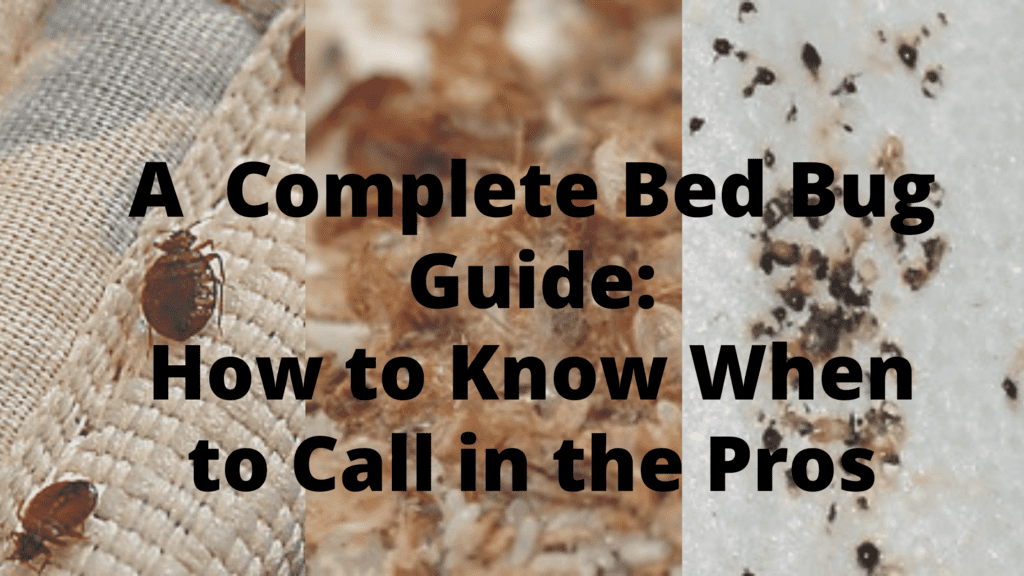We’ve all heard the phrase: “Good night, sleep tight! Don’t let the bed bugs bite!” Where did that come from anyway? That’s not a calming thought before going to bed. In the 1800s beds were made of straw, feathers, and other materials that attracted bed bugs. So people began saying that phrase. Even though beds as we know them became more readily available in the early 1900s, the phrase is still known today. Cultural idioms are sure weird!
In this bed bug guide you’ll learn all about bed bugs, including myths and facts; you’ll also learn different bed bug extermination methods, how we treat, and some next steps. For the best bed bug removal service, contact Done Right Pest Solutions: 651-342-9489.
Table of Contents
- Bed bugs
- Signs of bed bugs
- History of bed bugs
- Spread of bed bugs
- Myths and facts of bed bugs
- How pest professionals treat bed bugs
- How to inspect for bed bugs
- How we treat bed bugs
- Bed bug treatment prep checklist
- Why it’s important to have a professional treat
- Conclusion and next steps
Bed Bugs
Bed bugs are nocturnal, which means they are active during the night. These insects create little harborage areas in hidden locations, including in wall voids. For this reason, many don’t know they have bed bugs until there are many of them.
These insects feed on blood, mainly human, and are most active between the hours of 2 and 4 am, when most people are at their deepest stage of sleep. Bed bugs are attracted to carbon dioxide (the air we exhale from our lungs when we breathe). Our breaths are all the more attractive to these bugs when we are at our deepest sleep.
Their bites affect everyone differently. While some don’t notice any bite markings or itching, their partners or kids may be affected with the common symptoms of bed bug bites. Some common symptoms are red bite marks, raised skin due to swelling, heated skin, rash, and even mild fevers in some cases.
Bites from a bed bug have been misdiagnosed by medical professionals as a type of dermatitis like eczema or psoriasis.
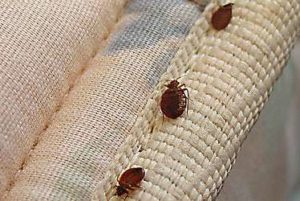
Hiring a pest control company that performs chemical treatment is the only sure fire way to get rid of bed bugs. So the answer to the question, “Can pest control get rid of bed bugs?” The answer is a resounding, “Yes!”
As you’ll learn in this article, there is a difference in quality and effectiveness of types of pest control treatments. But if you’re asking can Done Right Pest Solutions pest control get rid of bed bugs? Absolutely! We treat for bed bugs everyday.
Life Cycle
Bed bugs are small. Eggs are less than a millimeter, and adults are up to 5 millimeters long. Their oval bodies are fairly recognizable among many who travel or live in cities. Their coloring ranges among shades of browns with tints of red in them. Their abdomen is somewhat transparent, meaning you could tell if it had a meal recently.
Bed bugs reproduce by the male stabbing the female’s abdomen and then injecting its sperm into the wound. That sperm lasts to fertilize the eggs throughout the female’s lifespan. The females can lay between 1 and 10 eggs per day, up to 500 or more eggs in their lifetime.
Eggs are laid in dark, secluded areas: cracks and crevices, mattress and box spring seams, and in wall voids. It takes about 5 or 6 days to hatch, but once an egg hatches, the tiny bed bug will face 5 nymph life cycle changes before it reaches adulthood. Each stage will require at least one blood meal, and then it will molt.
Once the bed bug reaches the adult stage, it can live for more than a year with about weekly meals. It also has the unique ability to go long periods without a host- up to 6 months in the right climate. Bed bugs can swallow an air bubble to convince themselves that they don’t need a blood meal, and then they can sort of hibernate. It is with this ability that they pose a large threat to multi-family housing complexes and rental properties.
Bed bugs can swallow an air bubble to convince themselves that they don’t need a blood meal for up to 6 months in the right climate. With such resilience, it’s of vital importance to hire a competent pest control company to eradicate your bed bugs. Done Right Pest Solutions is that company! 651-342-9489.
Signs of Bed Bugs
Some detect the signs of bed bug activity with the symptoms these pests leave on their bodies: the bites, itching, minor swelling. These folks will notice these symptoms in the morning, typically. The physical bites can serve as early detection signs of bed bugs.
While others will begin to see some other details of a bed bug infestation: casings, fecal markings, smell.
Casings: As bed bugs molt, they leave their casings behind. Some may be left in wall voids, but mostly they may be left around baseboards, bed frames, and feet of the bed. These casings are usually clear, but may have light tan or light brown pigments.
Casings are one of the early detection signs of bed bugs. These casings mean that the bed bugs you have have begun reproduction and need to be taken care of immediately. You can find bed bug casings in bedding or bugs in bedding. If you do, it’s important to contact a pest control professional as soon as you can.
Bed bugs molt and lay eggs only after a blood meal. So bites from a bed bug will lead to casings, fecal markings, and bite markings.
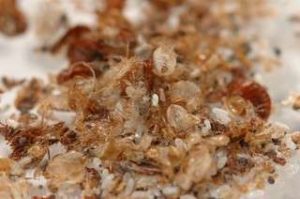
Fecal markings: After feedings, it is natural for insects to deposit fecal material. Bed bugs are no different. If you have bed bug activity, you may find black spots forming along the sides of your mattress or box spring. You may see these black spots in the crevices of mattresses as well. Bites from a bed bug will lead to fecal markings.
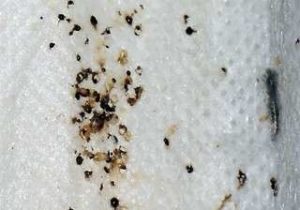
Bed bugs aren’t confined to the bedroom; they often will inhabit couches and chairs in living rooms too. You may find casings or fecal markings on these furniture items as a result.
Fecal markings are one of the early detection signs of bed bugs on sheets. Fecal markings are present wherever bed bugs are present, regardless if they are quite old enough to reproduce yet. It is important to know the early detection signs of bed bugs so you can respond accordingly.
Fecal markings on bedding is a great way to tell if you have bugs in bedding, bed bugs have most certainly been in your bedding.
Bed bug bites: One of the most tell-tale signs of whether you have bed bugs or not is bed bug bites. A bed bug bite can be misconstrued as a mosquito bite or spider bite. A bed bug bite is different, but can look similar depending on a number of different factors. It is also not uncommon for one partner to be more sensitive to a bed bug bite, while the other partner has no bites showing on their skin.
It is not known if bed bugs prefer a type of blood over another, all we know is everyone’s skin reacts differently to bites, whether from bed bugs, spiders, mosquitoes, or other biting insects. If you have bed bug bites on your person, you have had bugs in your bedding.
Bed bugs often bite in a line or a clump, as shown in the photo below. If you’re looking for bedroom bugs that bite or what a bite of a bed bug looks like, here is a photo that shows how they bite. Bedroom bugs that bite, also known as bed bugs, bite in a line (like the 3 on the left) or in a clump (more like the 4 on the right).
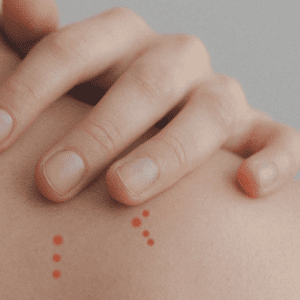
Smell: When squished, bed bugs emit an odor. Over time, this same odor can become known as their populations increase. The odor may vary, but it has been described as similar to decaying fruit or vegetables.
History of Bed Bugs
Bed bugs have been around a long time, and have fed on people the entirety of our existence. While they are parasitical creatures (they feed off of humans), they spend little time attached to their hosts. They spend more time in hiding.
Bed bugs are not subject to any culture, race, religion, or lifestyle; they are no respecter of persons. That said, bed bugs are also not a result of any level of hygiene or lack thereof.
Prior to the invention of the vacuum and pesticides, bed bugs ran more rampant and inhabited up to 30% of homes in the US (early- to mid-1900s).
DDT was created by a Swiss chemist between 1939-1940 and that helped eradicate a lot of the major bed bug problems throughout the United States and the world. But DDT was banned in the 1970s, which led researchers to develop alternative products to treat these pests. And then in the 1980s and 1990s there was a big increase on air travel, which helped quicken the spread of bed bugs.
These pests seem cyclical when it comes to changes in culture and travel. They spread in a number of ways, but one of the most common ways in more recent history is through the frequency and readiness of travel.
Bed bugs can easily travel on furniture items, in boxes and luggage, and in clothes and fabric items. For this reason, bed bugs are very versatile and will continue to survive and spread, though it is possible to prevent a bed bug infestation. It is up to pest management professionals to keep the populations from getting out of control. This helps increase health and quality of life and is vital to urban life.
They spread in a number of ways, but one of the number one ways in more recent history is through the frequency of and readiness of travel.
Spread of Bed Bugs
Bed bugs spread easily through second-hand items, in boxes and luggage, in clothes and fabric items, and through travel and sleeping accommodations.
Second-hand items: Like cockroaches, bed bugs can also be spread through second-hand items. It is important for a second-hand store staff to inspect all items for this reason. It is also important that you inspect your purchased items for these insect pests as well.
Boxes: Bed bugs can easily hide in boxes, so it is important to be mindful of this when storing items in a storage facility, in another’s home or garage, or when ordering items online.
Luggage: With the frequency of travel increasing in the 21st century, bed bugs can travel too, through luggage. Bed bugs and cockroaches can jump from suitcase to suitcase. While this is a scary thought, it isn’t common. Still, it is important to know that it can and does happen.
Clothes and fabric: Bed bugs can hide in clothes and fabric items if they are second-hand or returned after having been brought to an infested home and not thoroughly inspected upon return.
Sleeping accommodations: Sleeping accommodations are one of the biggest spread of bed bugs. Through hotels, motels, hostels, colleges, bed and breakfasts, or just staying at a friend or family’s home, bed bugs can easily be tuck themselves away in your items and come home with you. With the rise of travel, this is important to know and be aware of.
Rental Exchange: Exchange of tenants and rental properties is another cause of spread with these pests. Pest control is regulated for these properties to keep pest problems down and quality of life up.
The EPA strongly recommends all landlords to have preventative and responsible pest control employed in multi-family housing dwellings. Our expert technicians specialize in multi-family housing pest control and have an affordable pest control program for these large properties.
Rideshare: A new bonus method of transferring bed bugs from host to host and location to location is rideshare.
While these methods bed bugs use to travel are intimidating, it is important to continue as normal and just be aware. At the end of the day, if you know the warning signs and can spot them early on, treatment and management is simple and quicker than if the situation gets out of hand.
Because bed bugs spread so easily, it is important to contact pest control professionals for a bed bug removal service as soon as you notice activity. If you suspect you have bedbugs, call today for a free quote: 651-342-9489.
Myths and Facts Regarding Bed Bugs
Myth: The Scientific American produced an article with 10 myths about bed bugs. Among the 10 fascinating myths is that bed bugs only bite at night.
Fact: While they normally bite at night, they have been known to bite during the day. Though, if they do bite you during the day, your bed bug problem may be bigger than you think. Bed bugs will adapt to your schedule, so if you work at night and sleep during the day, bed bugs would be more likely to bite you during the day.
Myth: One of the biggest myths is that bed bugs like unsanitary conditions.
Fact: This is simply not true. Bed bugs are nondiscriminatory creatures. This is both settling and unnerving. Perhaps this is why bed bugs are often confused as lice, booklice, small roaches, and carpet beetles.
Myth: Bed bugs transmit diseases is another myth. Thank goodness!
Fact: While they can cause anxiety, stress, and in severe cases delusional parasitosis, they don’t transmit human pathogens, so they don’t transmit diseases to humans or from human to human. If you have ever been bit by a bed bug, chances are you received some stress from it.
Myth: Another myth is that you can treat bed bugs on your own with turpentine or natural products like wild mint or diatomaceous earth.
Fact: This is not true and these products do inhibit chemicals should you call an exterminator once those other methods don’t work. The best course of action to take upon bed bug activity discovery is to consult a pest professional!
Call Done Right Pest Solutions, the best bed bug exterminator in the Twin Cities metro area, and beyond! 651-342-9489.
How Pest Professionals Treat Bed Bugs
According to PCT Magazine not one treatment fits all needs; there are many ways pest professionals treat bed bugs, and it is important to have options depending on scenarios. Among the options are: heat treatments, chemical, canine, monitors, vacuums, and fumigation.
Heat treatments: Heat treatments are common, though are decreasing in popularity as chemical products become the norm due to less hassle, stress, and speed. Heat treatments involve a lot of prep work, removing anything from the home that could melt or catch fire. Then the pest professionals bring in machine equipment to heat the house to a certain temperature to kill off bed bugs.
Bed bug heat treatment exterminators also charge quite a bit of money for their services. While this method can have success, but because these bugs can also hide in wall voids, the temperatures would not be as hot in those crevices. This is why heat and chemical should go together, if one is using heat.
Chemical treatments: Chemical treatments are the most cost-effective treatments since they are quicker and cause less hassle. The prep work may vary per company, but the method is the same: application of a liquid chemical around baseboards, cracks and crevices, bed frame, box spring, etc. Depending on the product used, the dry time may differ. Once dry, residents can go about their day as normal and do laundry (on high heat setting).
Done Right Pest Solutions utilizes this method, and it’s why we have such high success ratings as a bed bug exterminator service. So, the answer to, “can pest control get rid of bed bugs?” the answer is, “Yes!”
Call now for the best bed bug service in Minnesota and Wisconsin: 651-342-9489.
Canine inspections: Canine inspections are a newer approach to bed bug treatment technology when it comes to detection. Humans don’t often smell bed bugs, but canine units can smell the blood they’ve eaten, as well as the rotting fruit or vegetable smell they emit upon large active sites.
Monitors: Monitors typically involve glue or sticky traps or pheromone traps that bed bugs cannot escape once they encounter these methods. These monitors are not a treatment option, but provide the customer with peace of mind and alert them if they have a recurrence. Monitors supplement treatment methods and help with management when it comes to large, multi-family housing complexes.
Vacuums: Vacuums are a good way to implement some semi-immediate results, but should never be the primary source of treatment. Vacuums supplement other treatment methods.
Done Right Pest Solutions utilizes this method, and it’s why we have such high success ratings as a bed bug exterminator service.
Fumigation: Fumigation is another form of bed bug treatment, which I would group similarly with heat treatments because of the severity and hassle of prep work. Fumigation treatments consist of removing all living things from the home, packing bags, and staying elsewhere, while pest professionals use a tent to fumigate the belongings and household for bed bugs. This process is extensive and while it can have success, there should be other treatment methods used as well.
Fumigation, like bed bug heat treatment exterminators, charge quite a bit of money for their services.
Heat treatments are common, though are decreasing in popularity as chemical products become the norm due to less hassle, stress, and speed. Heat treatments involve a lot of prep work, removing anything from the home that could melt or catch fire. Then the pest professionals bring in machine equipment to heat the house to a certain temperature to kill off bed bugs.
How to Inspect for Bed Bugs
Because bed bugs can hide in wall voids, cracks and crevices, they are among some of the hardest pests to treat. Identification and inspection/detection are key, and you can help with inspecting belongings for bed bugs to catch any bed bug activity early on!
Put a stop to bed bugs with these tips:
- Check sheets, pillows, corners of mattresses, and blankets for fecal material stains semi-regularly at home and always when traveling.
- Inspect head board, box spring, and under the bed if possible for any harborage sites or casings.
- Inspect any seams or indents for fecal material or other signs of activity.
- Check luggage before and after travel to find immediate activity.
- You can also check yourself for bed bug bites. While this is not a definitive reason to have a bed bug treatment, it can be helpful in diagnosing the issue. Bed bugs bite distinctive patterns, as shown above.
- Know the early detection signs of bed bugs from the “signs of bed bugs” section above.
How We Treat for Bed Bugs
Done Right Pest Solutions takes pride in its success regarding bed bug extermination and cockroach extermination. Our staff has 15 years of experience eradicating these pests in multi-housing complexes and residential homes. Unlike bed bug heat treatment exterminators, we require NO prep work, but have information available if you have tenants and want them to minimally prepare in order to help ensure success. Bed bug eradication is a team effort!
The reason why we require no prep work is because bed bugs can get spooked and go into hiding. We want to see the activity on a normal day, so we request that you go about your business as normal and the bugs will too. Then, when we come in, we can see the full level of activity and determine how best to treat.
Our technicians first perform bed bug inspection techniques, remove any visible activity, treat thoroughly, and depending on the situation may give tips of how to monitor for activity. We ensure a 2 week follow-up is provided, and a 3 month warranty from the first date of service is a company standard.
Removing visible activity: Our technicians may use a roach and bed bug vacuum to suck up all bed bug activity if they deem it necessary, from live to dead bugs and casings. This provides a level of immediate gratification, though we ensure that if the activity is high, you will see some activity going forward until the 2 week follow-up.
Treating thoroughly: Once the bed bug activity is removed, our technicians use a liquid product applied to baseboards, head boards, bed frames, box springs, and other areas the technician sees fit. Our product typically dries within 45 minutes to an hour, and then is safe to the touch. Keep in mind that it is a chemical and is designed to kill pests and is therefore recommended not to be touched when wet.
Depending on your routine, the technician may recommend laundering sheets and clothes in the bed rooms on high heat. This can be done after the first treatment.
After the treatment, do not shampoo carpets or wash down the baseboards, bed frames, bed posts, and other treated areas because the dry, residual product will keep working for weeks to months to come.
The 2 week follow-up is vital to bed bug eradication. Bed bugs hide their eggs in hard to reach areas and wall voids. So when the eggs are hidden, they aren’t treated so the product doesn’t penetrate the shell to kill the bed bug. It takes 5-6 days or so for the bed bug to hatch, so the 2 week follow-up ensures that those bed bugs will die before they can reach sexual maturity and reproduce.
The 3 month warranty gives our customers peace of mind. We do not charge trip fees, so if you see any activity after the 2 week follow-up, give us a call! 651-342-9489
The reason why we require no prep work is because bed bugs can get spooked and go into hiding. We want to see the activity on a normal day, so we request that you go about your business as normal and the bugs will too. Then, when we come in, we can see the full level of activity and determine how best to treat.
Can pest control get rid of bed bugs? Yes, we can! Give us a call for a free quote today: 651-342-9489.
Bed bugs are definitely invasive! For tips and tricks with all invasive pests, check out our category within our blog.
Bed Bug Treatment Prep Checklist
Done Right Pest Solutions has expert technicians who have specific skills in bed bug removal service and cockroach removal service. What’s more exciting for our clients than quick, effective bed bug removal service is our low-maintenance approach to our service. Many companies will have a long bed bug treatment prep checklist. Some common items are to remove all bedding and clothes, to remove all flammable items, all medications, all art, any items that could melt, and more!
Bed bug heat treatment exterminators understand that items within a house can become damaged upon the bed bug heat treatment service. But, since Done Right Pest Solutions takes a simple, chemical approach to bed bug removal service, the bed bug treatment prep check list is much, much shorter!
All we ask is that you be present at time of service so you can ask the technician any questions. If there is any moving of beds or dressers away from the walls, the technician does this. In short, Done Right Pest Solutions has NO bed bug treatment prep checklist.
Our technicians perform the bed bug prep service so you don’t have to. This is part of our quality service and our quality customer service. We have found that if clients perform their own bed bug prep service prior to the bed bug removal service, the bed bugs go off hiding in the walls and the full extent of activity isn’t always known so the technician doesn’t always treat appropriately.
For that reason, our technicians will always perform the bed bug prep service so you don’t have to. With no prep work, there’s no better company to call for bed bug extermination than Done Right Pest Solutions: 651-342-9489.
Why It’s Important to Have a Professional Treat
The Environmental Protection Agency knows how difficult pest eradication is. The point of pest control is to increase quality of life, health, and control and diminish the spread of illness and disease.
It is important to have a pest professional treat for bed bugs because we:
- Are trained experts
- Use high quality bed bug inspection techniques
- Have access to leading, successful methods in the field
- Have done this before (many who DIY pest control are beginners)
- Operate equipment that can reach hard to treat areas
- Offer follow-ups and warranties
- Can provide tips and tricks from years of experience and research
Conclusion & Next Steps
Bed bugs are a touchy subject to many, whether for fear or bad memories. Though it’s OK to be scared, you don’t need to be. You’ve got more knowledge about these pests, and Done Right Pest Solutions in your pocket if you need us.
While these methods bed bugs use to travel are intimidating, it is important to continue as normal and just be aware. At the end of the day, if you know the warning signs and can spot them early on, treatment and management is simple and quicker than if the situation gets out of hand.
You learned a lot in this thorough bed bug guide including signs, history, and spread of bed bugs over the years. You even learned some myths and facts regarding bed bugs and extermination. We noted to never use products like diatomaceous earth to treat bed bugs, especially if you call in professionals, as this product can take away the successfulness of the chemical product pest professionals use.
You learned different methods that pest control professionals use to treat these pests, how we treat for these pests, and how to perform your own inspections for bed bugs. At the end of the day, we want you to be pest free, and part of that means hiring a pest professional to treat for pests that are tricky. Bed bugs are such pests.
If you are in need of bed bug inspection or treatment, please give Done Right Pest Solutions a call. We know what we are doing and we are here to help. 651-342-9489.
- For more contact info, visit our Contact Us page.
- For more service options, visit our Services page.
- Call for a free quote or check out our Bed Bug Service Page for bed bug pest control cost estimate examples.
Done Right Team
What did you find helpful in this bed bug guide? What is one thing you may put into practice while traveling? We want to know your thoughts.
Want to learn more about different pests? Or maybe about services and promotions we offer? Sign up for our free newsletter!

